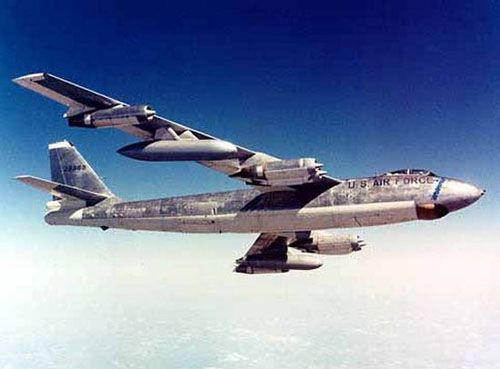Boeing B-47 Stratojet
Summary
| Category | Bomber |
| Origin country | 🇺🇸 United States |
| First flight | 17 December 1947 |
| Year of introduction | 1952 |
| Number produced | 2042 units |
| Average unit price | $3 million |
Description
The B-47 Stratojet was a strategic bomber developed by the United States in the early years of the Cold War, in response to the U.S. Air Force's requirement for a high-speed, long-range bomber capable of carrying nuclear weapons.
Development of the B-47 began in the late 1940s. The goal was to create a jet-powered bomber capable of operating at high altitudes and high speeds, providing a nuclear deterrence capability. The Boeing design team, led by engineer Ed Wells, worked on developing an innovative swept-wing design for the aircraft, which would enhance its performance and fuel efficiency.
The first prototype of the B-47 made its maiden flight on December 17, 1947. The B-47 was powered by six paired-mounted jet engines under its swept wings, enabling it to achieve speeds close to the speed of sound. For takeoff, it had JATO (Jet-Assisted Takeoff) rockets to provide additional power.
To increase the available space in the fuselage for the bomb bay, it featured a bicycle-style landing gear, which also had the advantage of not compromising the aircraft's performance. Ground stability was augmented by two outriggers located under the engine nacelles.
The B-47 was primarily stationed at Strategic Air Command (SAC) bases, including those in the United States, Europe, and the Pacific. These bases provided strategic positioning for the aircraft to respond to potential threats and carry out long-range bombing missions.
During the 1950s and 1960s, the B-47 conducted numerous training exercises and deployments to showcase its capabilities and demonstrate American military strength. It was also involved in reconnaissance missions, such as overflights of the Soviet Union, to gather intelligence on enemy territory.
As the Cold War escalated, the operational deployment of the B-47 expanded. The aircraft played a significant role during the Cuban Missile Crisis in 1962, where it was placed on high-alert status and prepared for potential nuclear strikes. However, the B-47 did not participate in any major conflicts.
Over time, the role of the B-47 shifted from being a nuclear bomber to a platform for other missions. It was adapted for various roles, including electronic intelligence gathering (EB-47), weather reconnaissance (WB-47), and aerial refueling (KB-47). These modified versions served alongside the standard B-47 bombers.
As new bombers, such as the B-52 Stratofortress, were introduced, the B-47 gradually phased out of service. The last operational flight of the B-47 took place in 1966, and the aircraft was officially retired from active service in 1969. In total, 2032 aircraft were built.
Technical specifications
| Version: B-47E | |
|---|---|
| Crew | 3 members |
| Operational range | 3240 km (2013 mi) |
| Maximum speed | 977 km/h (607 mph) |
| Wing area | 132.7 m² (1428.4 sqft) |
| Wingspan | 35.4 m (116.0 ft) |
| Height | 8.5 m (28.0 ft) |
| Length | 32.7 m (107.1 ft) |
| Service ceiling | 10089 m (33100 ft) |
| Empty weight | 35867 kg (79073 lbs) |
| Max. takeoff weight | 100000 kg (220462 lbs) |
| Climb rate | 23.7 m/s (77.8 ft/s) |
| Powerplant | 6 × turbojets General Electric J47-GE-25 delivering 3266 kgp |
Current operating countries
No country is operating the B-47 Stratojet in 2025.
All operators
Armament
Bombs payload:
- Thermonuclear Mk 15
Photo of B-47 Stratojet

3-view profile
